How Do Sensory Systems Differ For Humans Versus Nonhuman Animals?ã¢â‚¬â€¹
Learning Objectives
- Distinguish between the functions of classes of sensory receptors (mechanoreceptors, chemoreceptors, photoreceptors, nociceptors)
- Explicate the 3 general mechanisms by which the magnitude or caste of the stimulus (analog data) is accurately communicated via activeness potentials (digital signals) to the CNS and identify these mechanisms in case sensory systems
- Explain, compare, and contrast how stimuli related to bear upon, hearing, sight, taste, smell, and pain are detected, transmitted, and interpreted by the brain
- Compare and contrast mechanisms of visual and vestibular perception among different animals lineages
Sensory Processing in Animals
The information below was adjusted from OpenStax Biology 36.0 and OpenStax Biology 36.1
The sensory organization detects signals from the exterior environment and communicates it to the body via the nervous system. The sensory system relies on specializedsensory receptor cells thattransduce external stimuli into changes in membrane potentials. If the changes in membrane potential are sufficient to induce an activeness potential, so these activeness potentials are and so communicated along neurons within the afferent partition of the PNS to the CNS for information processing. The CNS integrates and interprets the incoming signals to effect a response to the appropriate torso systems via the efferent partition of the PNS.
Sensory receptor cells can be:
- specialized neurons (the receptor cell is also a neuron)
- specialized sensory cells which synapse with a neuron (the receptor cell secretes neurotransmitters to stimulate changes in membrane potential in the synapsed neuron)
Sensory receptor cells transduce (catechumen into changes in membrane potential) incoming signals and may eitherdepolarize orhyperpolarizein response to the stimulus, depending on the sensory system. In vertebrates, each sensory system transmits signals to a unlike specialized portion of the brain such equally the olfactory bulb (smell) or occipital lobe (sight), where the betoken is integrated and interpreted to effect some sort of response (often motor output) via the PNS.
Different sensory receptor cells are specialized for different types of stimuli, and are categorized by the type of stimulus they detect. Sensory receptor cells include (but are not limited to!)
- Mechanoreceptors: respond to concrete deformation of the cell membrane from mechanical energy or pressure, including bear on, stretch, motion, or audio
- Chemoreceptors: respond to specific molecules, often dissolved in a specific medium (such equally saliva or mucus), or airborne molecules
- Photorecetpors: answer to radiant energy (visible light in most vertebrates; visible also as UV light in many insects)
- Nociceptors: reply to "noxious" stimuli, or essentially anything that causes tissue harm
- Thermoreceptors: reply to heat or cold
All bilaterally symmetric animals have a sensory system, and the development of whatsoever species' sensory organisation has been driven by natural selection; thus, sensory systems differ among species according to their history of natural selection. For instance, the shark, unlike most fish predators, is electrosensitive- that is, sensitive to electrical fields produced by other animals in its environment.
Humans and many other vertebrates have at least 5 special senses: olfaction (smell), sense of taste (taste), equilibrium (balance and torso position), vision, and hearing. Additionally, nosotros possess general senses, also called somatosensation, which answer to stimuli like temperature, hurting, pressure, and vibration.
Analog to Digital: Encoding and Transmission of Sensory Information
Sensory stimuli vary in intensity. For example, a sound can be a whisper or a shout. Nevertheless the stimulus is transmitted via activeness potentials in the sensory neurons, which are "all or nothing" events that exercise not vary in intensity. How do we notice and perceive the difference betwixt a shout and a whisper? The intensity or caste of a stimulus is often encoded in three different ways:
- Therate or frequency of action potentials produced by the sensory receptor. For example, an intense stimulus will produce a more rapid serial of activity potentials, and reducing the stimulus volition likewise slow the rate of production of action potentials. (Annotation the intensity affects the rate of production of activeness potentials, not the speed with which the action potential travels along the axon.)
- The number of receptors activated. For example, an intense stimulus might initiate action potentials in a large number of adjacent receptors, while a less intense stimulus might stimulate fewer receptors.
- Whichspecific receptors are activated. For example, a low pitch or volition initiate activeness potentials in 1 set of sensory neurons, while a high pitch will initiate action potentials in a dissimilar set of sensory neurons.
Look for these patterns described higher up as you complete the remaining cloth on this page.
Survey of Sensory Systems
Beneath are discussions of several unlike sensory systems in different types of animals. For each sensory system, be prepared to identify, compare, and dissimilarity each of the post-obit:
- What is the stimulus and what type of receptor detects information technology?
- Is the receptor a receptor cell, or a specialized neuron?
- How is the stimulus transduced into a change in membrane potential?
- What happens in the sensory receptor when the stimulus is recognized?
- How is the intensity/degree/magnitude of the stimulus communicated to the CNS?
Mechanoreceptors: Touch, Sound, Balance
Mechanoreceptors sense stimuli due to physical deformation of their plasma membranes. They incorporate mechanically gated ion channels whose gates open up or close in response to pressure, touch, stretching, and audio.
Bear upon: the Somatosensory System
The information below was adjusted from OpenStax Biology 36.1
Somatosensation is the sense of impact. Somatosensation occurs all over the exterior of the body and at some interior locations as well. The sense of bear upon is detected by a variety of different types of mechanorecetpors that are embedded in the skin, mucous membranes, muscles, joints, internal organs, and cardiovascular system. In fact, what is commonly referred to as "touch" involves more than one kind of stimulus and more than 1 kind of receptor. Touch in humans includes four primary tactile mechanoreceptors in the skin. You lot don't need to know the specific name for each blazon of touch receptor (shown below), only you should be able to recognize that
- some types of mechanoreceptors are located near the upper layers of the skin, and are thus more sensitive to lighter bear upon and are able to precisely localize gentle touch
- other types of mechanoreceptors are located deeper in the pare, and are thus just activated by stronger pressure and are non equally highly sensitive to identify the precise location of the touch.
A calorie-free touch activates just the mechanoreceptors about the upper layer of the skin, while a firmer touch activates mechanoreceptors deeper in the skin, in add-on to the mechanoreceptors about the surface of the skin. A firmer touch on will also activate a greater number of receptors, and may induce more frequent action potentials in the receptors than a lighter touch.,
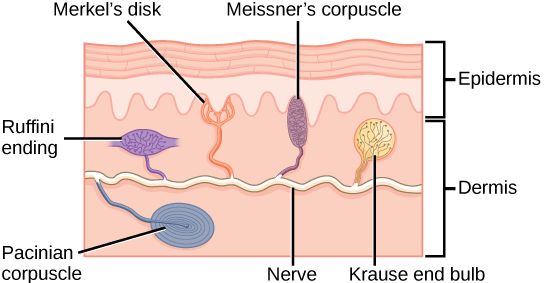
4 of the primary mechanoreceptors in human skin are shown. Merkel'southward disks, which are unencapsulated, reply to light touch. Meissner's corpuscles, Ruffini endings, Pacinian corpuscles, and Krause end bulbs are all encapsulated. Meissner's corpuscles reply to touch and depression-frequency vibration. Ruffini endings find stretch, deformation within joints, and warmth. Pacinian corpuscles find transient pressure and high-frequency vibration. Krause finish bulbs detect cold. Image credit: OpenStax Biology.
Sound: the Auditory System
The information below was adapted from OpenStax Biology 36.4
Auditory stimuli are sound waves, which are mechanical pressure level waves that move through a medium, such equally air or water. (There are no sound waves in a vacuum since there are no air molecules to motion in waves.) Considering sound waves exert pressure, sound is detected past mechanoreceptors.
As is true for all waves, there are iv chief characteristics of a audio moving ridge: frequency, wavelength, menstruation, and amplitude. Three of these are important for understanding how hearing works:
- Frequency is the number of waves per unit of measurement of time, which is heard as pitch. Frequency is also related to wavelength, where high-frequency (15,000 Hz) sounds are higher-pitched and shorter wavelength than depression-frequency, long wavelength (100 Hz) sounds. Nigh humans can perceive sounds with frequencies between xxx and xx,000 Hz. Dogs discover upwards to near 40,000 Hz; cats, sixty,000 Hz; bats, 100,000 Hz; and dolphins 150,000 Hz, and some fish tin hear 180,000 Hz.
- Aamplitude, or the dimension of a wave from peak to trough, in audio is heard every bit volume. The sound waves of louder sounds have greater aamplitude than those of softer sounds. For audio, volume is measured in decibels (dB). In the figure below, the softest sound that a human can hear is the zero point. Humans speak normally at sixty decibels.
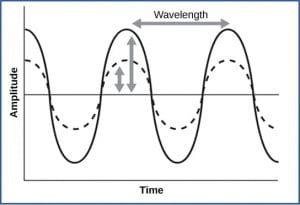
For sound waves, wavelength corresponds to pitch. Amplitude of the wave corresponds to volume. The audio wave shown with a dashed line is softer in volume than the sound wave shown with a solid line. (credit: NIH via OpenStax Biology)
- Outer ear:
- Sound waves are nerveless by the external, cartilaginous part of the ear
- Audio waves then travel through the auditory culvert and cause vibration of the ear drum (tympanic membrane)
- Middle ear:
- The eardrum transmits sound to the eye ear by vibrating the ossicles, the three small bones of the middle ear which collect strength and amplify sounds. The iii ossicles are unique to mammals.
- Inner ear:
- The ossicles transmit the vibrations to a thin membrane called the oval window, which is the outermost construction of the inner ear.
- The vibrations of the oval window create pressure waves in the fluid inside the cochlea. The cochlea is a whorled structure, like the shell of a snail, and it contains receptors for transduction of the mechanical wave into an electrical indicate
- Within the cochlea, the basilar membrane is a flexible membrane that runs the length of the cochlea, and contains the mechanoreceptors called pilus cellswhich transduce audio waves into action potentials. The basilar membrane vibrates in response to sound pressure level waves, pressing the hair cells against thetectorial membrane, which physically bends the pilus cell cilia, initiating action potentials in the afferent neurons that communicate sounds stimuli to the encephalon.

Sound travels through the outer ear to the middle ear, which is bounded on its outside by the tympanic membrane. The middle ear contains three bones called ossicles that transfer the sound wave to the oval window, the outside purlieus of the inner ear. The organ of Corti, which is the organ of audio transduction, lies inside the cochlea. (credit: OpenStax Biology, modification of work past Lars Chittka, Axel Brockmann)
When the sound waves in the cochlear fluid contact the basilar membrane, the basilar flexes back and forth. The basilar membrane'south flexibility changes along its length, such that it is thicker, stiffer, and narrower at one stop of the chochlea, and thinner, floppier, and broader at the other cease. Every bit a issue, different regions of the basilar membrane vibrate co-ordinate to the frequency of the sound moving ridge conducted through the fluid in the cochlea, with the stiffer region vibrating in response to high frequency (college-pitched) sounds, and the more than flexible region vibrating in response to low frequency (lower-pitched) sounds. In other worlds, pitch is detected based on which region of the basilar membrane vibrates in response to a sound (and thus which hair cells are activated).
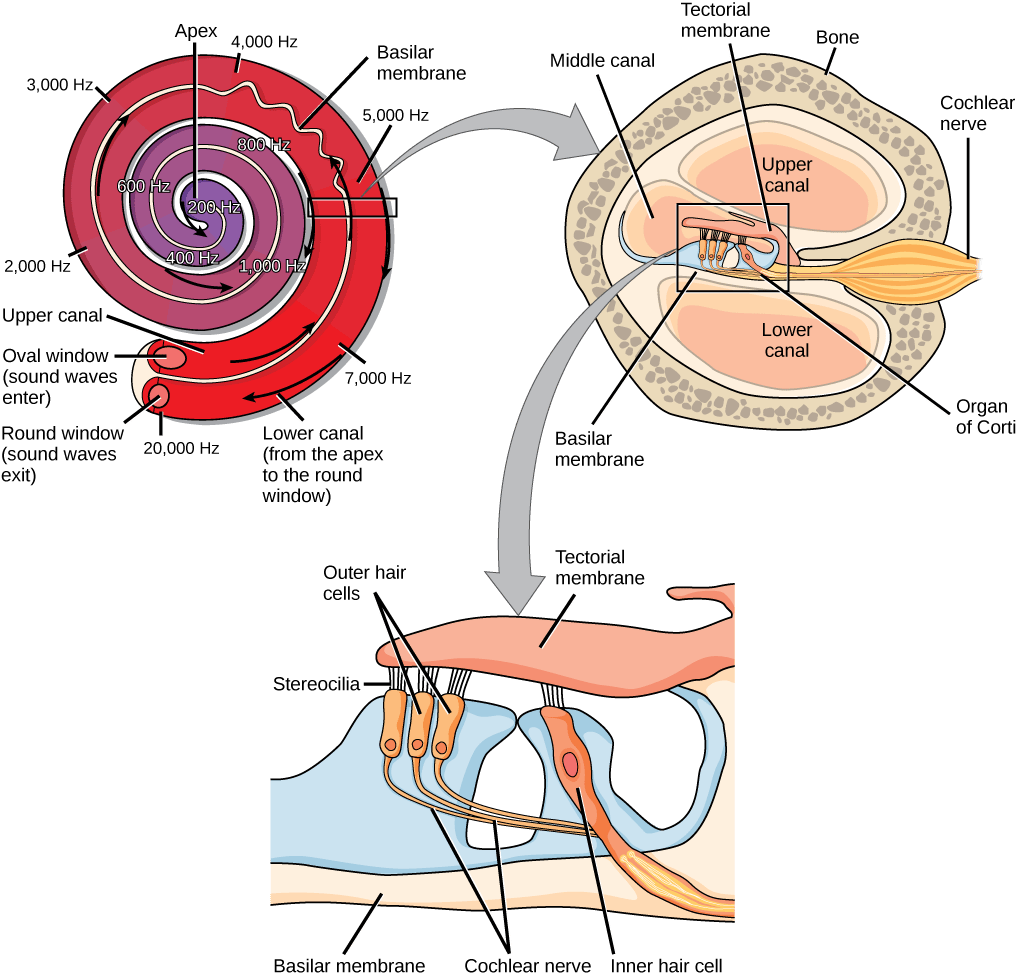
In the mammalian ear, sound waves cause the stapes to printing against the oval window. Vibrations travel up the fluid-filled interior of the cochlea. The basilar membrane that lines the cochlea gets continuously thinner toward the apex of the cochlea. Different thicknesses of membrane vibrate in response to different frequencies of sound. Audio waves then exit through the round window. In the cross section of the cochlea (top right figure), note that in addition to the upper canal and lower canal, the cochlea also has a middle canal. The organ of Corti (bottom prototype) is the site of audio transduction. Move of stereocilia on hair cells results in an action potential that travels along the auditory nervus. Image credit: OpenStax Biology.
The site of transduction from sound waves to action potentials is in the organ of Corti (spiral organ). How is sound transduced from a wave to an activeness potential? Within the organ of Corti, pilus cells are held in place above the basilar membrane with their hair-similar stereocilia embedded in the tectorial membrane higher up them. When a sound wave flexes the basilar membrane:
- The hair cells on the basilar membrane are flexed against the tectorial membrane, which bends the stereocilia
- The bending of the stereocilia causes potassium ion channels to open in the jail cell membrane; the hair cell is bathed in a solution high in potassium, so potassium rushes into the prison cell through the open channels, depolarizing the hair cell
- Only like in a synaptic terminal, membrane depolarization ultimately causes synaptic vesicles in the hair cell to fuse with the plasma membrane, releasing neurotransmitters into the synaptic crack between the hair jail cell and its synapsed afferent neuron
- If the resulting depolarization is sufficient, an activity potential is transmitted to the chochlear nerve. Intensity (book) of sound is determined by how many hair cells at a particular location are stimulated, while pitch is determined by which particular hair cells along the basilar membrane are stimulated

Bending of cilia (yellowish) in hair cells in the inner ear in response to sound pressure waves results in opening of potassium channels that depolarize the hair cells, crusade release of neurotransmitters on the synapsed sensory neurons (shown in bluish), and can trigger activeness potentials (APs) in the axons of those neurons. Image credit: Modification of work by Thomas.haslwanter – Ain work, CC BY-SA 3.0, https://commons.wikimedia.org/w/alphabetize.php?curid=14585601
This video provides a quick overview of mammalian cochlear function in hearing:
Balance and Motion: the Vestibular Arrangement
The stimuli associated with the vestibular system are linear acceleration (gravity) and angular acceleration and deceleration. Gravity, acceleration, and deceleration are detected by evaluating the inertia on receptive cells in the vestibular system. In vertebrates, gravity is detected through head position. Angular dispatch and deceleration are expressed through turning or tilting of the head.
The vestibular system in vertebrates has some similarities with the auditory arrangement. It utilizes hair cells located within the ear in a structure called the vestibular labyrinth (located side by side to the cochlea), but it activates them in a different fashion compared to the auditory organization. Pilus cells in the vesibular labyrinth observe signals in two ways:
- Some hair cells lie below a gelled layer, with their stereocilia projecting into the gelatin. Embedded in this gelatin are calcium carbonate crystals,like tiny rocks, that movement in response to gravity. Whatever time the head is tilted at an angle or is subject to acceleration or deceleration, these crystals crusade the gelatin to shift, bending the stereocilia. The bending of the stereocilia stimulates the neurons, and they signal to the brain that the head is tilted, assuasive the maintenance of rest.
- Some hair cells project into a gelatinous cap called the cupula. When the head turns, the fluid in the canals shifts, thereby bending stereocilia and sending signals to the brain. When movement stops, the movement of the fluid inside the canals slows or stops.

Hair cells in the semicircular canals have projections that extend into cupulas, which move in response to changes in acceleration or deceleration. Prototype credit: By NASA – Source: The Furnishings of Space Flight on the Homo Vestibular System, an online educational article by the U.South. regime'southward National Aeronautics and Space Administration (NASA), Public Domain, https://eatables.wikimedia.org/w/index.php?curid=6765835
This video provides a quick overview of the mammalian vestibular system:
A similar system involving hair cells and a cupula is nowadays at the lateral lineof bony fish, which are used to find changes in h2o pressure.
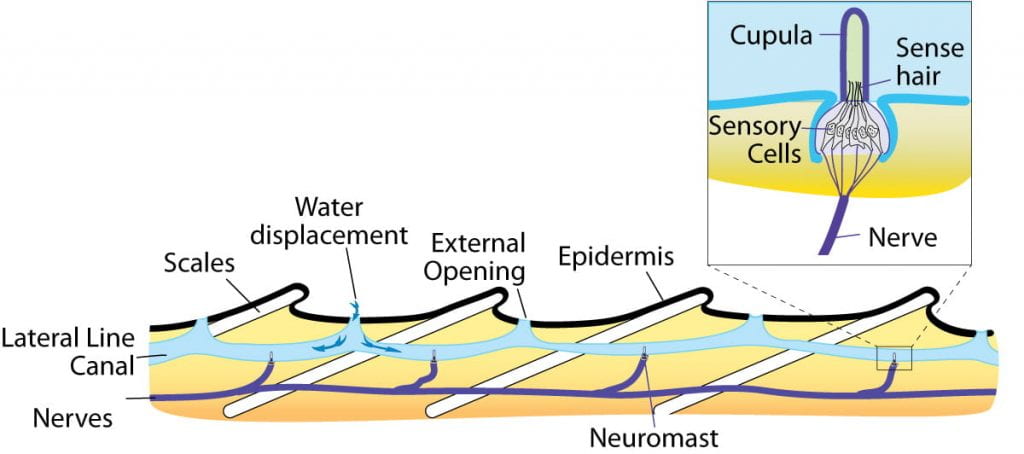
The lateral line extends downwardly the trunk of bony fishes. The canal of the lateral line is lined with sensory pilus cells with projections that extend into cupulas. The canal allows water to enter from the surrounding surround, which tin can band the cupulas equally h2o pressure changes, triggering action potentials in the sensory neurons synapsed with the hair cells. By Thomas.haslwanter – Own work, CC BY-SA three.0, https://commons.wikimedia.org/w/index.php?curid=21451808
Many invertebrates detect residue through a construction chosen astatocyst, a ball-shaped organ lined with inward-facing hair cells and containing statoliths, dumbo particles like to calcium carbonate crystals in the vertebrate utricle and saccule. Any movement causes the statoliths to modify location inside the statocyst, activating different hair cells every bit they motility.
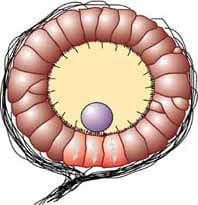
Statocysts contain inward-facing hair cells (brown) that detect movements of statoliths (purple), dumbo particles that motility in response to gravity. The hair cells are synapsed with sensory neurons (black lines) that communicate sensory information to the encephalon. Prototype credit: Davis, W. J. (1968) – http://caspar.bgsu.edu/~courses/Neuroethology/Labs/Images/Statocyst.jpg, Public Domain, https://commons.wikimedia.org/w/index.php?curid=22495818
Photoreceptors: Vision
Every bit with auditory stimuli, light travels in waves. The pressure waves that create audio must travel in a medium: a gas, a liquid, or a solid. In dissimilarity, light is composed of electromagnetic waves and needs no medium; low-cal can travel in a vacuum (this is why we can see stars from space.) The beliefs of light tin can exist discussed in terms of the behavior of waves and also in terms of the behavior of the central unit of measurement of lite: a packet of electromagnetic radiations called a photon. Humans tin perceive simply a small slice of the entire electromagnetic spectrum, which includes radiations that nosotros cannot come across as light because it is below the frequency of visible red light and above the frequency of visible violet low-cal, which are the limits of vertebrate light detection.
Certain variables are important when discussing perception of calorie-free:
- Wavelength (which varies inversely with frequency) is detected every bit hue, or color. Low-cal at the red finish of the visible spectrum has longer wavelengths (and is lower frequency), while low-cal at the violet end has shorter wavelengths (and is higher frequency). The wavelength of lite is expressed in nanometers (nm); i nanometer is ane billionth of a meter. Humans perceive light that ranges between approximately 380 nm and 740 nm. Another animals, though, can detect wavelengths outside of the homo range. For case, bees run into nigh-ultraviolet light in guild to locate nectar guides on flowers, and some non-avian reptiles sense infrared light (oestrus that prey gives off).
- Moving ridge amplitude is perceived as luminous intensity, or effulgence.
Detection of light occurs throughphotoreceptors, cells that contain pigment-absorbing molecules that absorb light. Photoreceptor cells are typically located in light-collecting organs called eyes. Eyes vary in structure in different types of animals and include:
- eye cups in flatworms, which are dimple-shaped structures that notice the management of a light source
- compound eyes of arthropods, which contain multiple lenses and detect shapes, patterns, and movements
- pinhole optics in the nautilus, which incorporate no lens and forms simple, depression-resolution images
- simple eyes of cephalopods and vertebrates, which incorporate a single lens and form high-resolution images
Many of these types of eyes, which are present in living organisms today, may accept besides represented a pathway of evolution from a simple patch of photosensitive cells to simple lens optics of vertebrates and cephalopods:

By Matticus78 at the English language language Wikipedia, CC BY-SA 3.0, https://eatables.wikimedia.org/west/index.php?curid=2748615
This video describes the evolutionary origins of the man middle:
The vertebrate centre contains the post-obit structures:
- Sclera: tough outer tissue (white of the middle)
- Cornea: transparent sheet of connective tissue, functions with the lens to focus calorie-free on the retina
- Iris: pigmented band of musculus that controls amount of low-cal entering eye
- Pupil: hole in center of iris
- Lens: crystalline, curved structure that focuses low-cal on the cornea (by bending, non past moving) in conjunction with the cornea
- Retina: thin layer of photoreceptor cells and neurons
- Photoreceptor cells: lite-detecting sensory cells
- Bipolar cells: intermediate connecting neurons
- Ganglion cells: neurons whose axons projection to the encephalon via the optic nerve
- Fovea: site of retina with only cones, surface area of highest visual resolution
- Optic nerve: axons of the ganglion cells

(a) The human eye is shown in cross section. (b) A blowup shows the layers of the retina. Image credit: OpenStax Biological science
The vertebrate heart is pretty good at forming high-resolution images, though perhaps nosotros are a little biased in making that assessment. But it turns out that that the vertebrate eye is actually far from platonic. In fact, the cephalopod eye, which looks the same on the surface but evolved independently, is far better. Here is a comparison betwixt the vertebrate and cephalopod optics:
- Cephalopod eyes move the lens to focus (like in a photographic camera), rather than irresolute lens shapeas in the vertebrate eye; the result in vertebrates is historic period-related loss of resolution every bit the lens loses flexibility over time
- Vertebrate optics have an "inverted" retina, where claret vessels and nerves are in forepart of the photreceptor cells, unlike in the cephalopod eye where the nerves arebehind the photoreceptor cells; the result in vertebrates is the blind spot too age-related macular degeneration and increased likelihood of retina detachment (a severe medical emergency) due to the loose association between the retina and the back of the centre

The vertebrate and cephalopod optics are very like but with key differences, including the relative locations of the photoreceptors and sensory neurons (the retina is "inverted" in the vertebrate heart, resulting in a blind spot where the optic nerve exits the retina), and the movable lens in cephalopods compared with a flexible lens in vertebrates. Image credit: modification of work by Past Philcha, Public Domain, https://commons.wikimedia.org/w/index.php?curid=4612105
Regardless of the structure of the centre, all photoreception relies on low-cal-absorbing pigment molecules embedded in the photoreceptor cells. This pigment is called retinal, and it is independent in a protein called opsin . Together, they class a complex calledrhodopsin, that allow usa to find lite and color. Both the protein and the paint are essential for this process:
- The pigment: retinal, reversibly changes shape when information technology is hit by a photon of low-cal (this process is extremely like to detection of red vs far-red light by phytochrome in plants.)
- The protein:opsin, holds the retinal paint and changes shape/activity when the retinal changes shape in response to assimilation of light. Opsins are responsible for our ability to perceive differences in color or hue. Humans accept three color-sensitive opsins: S opsin (brusque-wavelength opsin), M opsin (medium-wavelength opsin), and L opsin (long-wavelength opsin).
- The photoreceptor cells:rods andcones each incorporate a unique opsion that causes the cell the cell to be almost sensitive to a specific wavelength of calorie-free. Keep in mind that the retinal is always the same; it is the opsin that varies in dissimilar photoreceptor cells
- Cones (which are cone-shaped) each comprise a single blazon of colour-sensitive opsin, making each cone almost sensitive to a particular hue or color of light. Though we just accept iii types of cones (due to the iii types of color-sensitive opsins), nosotros are able to find and so much variation in hue to do activation of dissimilar combinations of cones at the same time. Cones require high-levels of light to piece of work, which is why nosotros tin't perceive color well in the nighttime. Cones are heavily concentrated at thefovea and are useful for focusing on important visual details.
- Rods (which are rod-shaped) each contain a 4th blazon of opsin called rod opsin, which is activated by an intermediate wavelength of light and is capable of working in depression-levels of light. Rods are not color-sensitive, but permit usa to see in low levels of lite. Rods are heavily concentrated at the periphery (outer edges) of the retina, and are useful for detecting move in our field of vision.

Human rod cells and the different types of cone cells each have an optimal wavelength. However, there is considerable overlap in the wavelengths of low-cal detected. Image credit: OpenStax Biology
This video provides a brief explanation of how nosotros can perceive then many different colors with only iii types of cones:
What happens when a photon activates rhodosin? Different all the other sensory systems we accept discussed, a rod or cone jail cellhyperpolarizes when its rhodopsins are activated past light, and information technologydepolarizes when its rhodopsins are in the dark. This means that, when in the dark, our rods and cones are depolarized and thus releasing neurotrasnsmitters to their synapsed bipolar cells. When a rod or cone cell is activated by light, information technology hyperpolarizes andstops releasing neurotransmitter.
Chemoreceptors: Sense of taste (Gustation) and Olfactory property (Olfaction)
The information below was adapted from OpenStax Biology 36.iii
Gustation, also chosengustation, and scent, as well calledolfaction, are interconnected senses. Both involve molecules of the stimulus inbound the trunk and bonding to receptors, relying onchemoreceptors, receptors that are sensitive to specific chemicals. Merely every bit each photoreceptor jail cell is sensitive to a specific wavelength of low-cal based on the opsin present in the prison cell, each chemoreceptor cell is sensitive to a particular molecule based on the poly peptide receptor nowadays in the cell.
Sense of taste: the Gustatory System
The primary tastes detected past humans are sweet, sour, bitter, salty and umami (savoriness, which tends to indicate that a food is high in protein).
Detecting a taste relies on activation of specific chemical receptors in taste receptor cells ( gustatory receptors). When the specific chemical (tastant) binds the receptor, the receptor cell becomes depolarized and releases neurotransmitter on its synapsed afferent neuron. As in other sensory systems, specificity in taste occurs because each gustation receptor cell has merely 1 type of protein receptor which is sensitive to either sweet, sour, biting, salty, or umami. The process of depolarization differs based on the specific blazon of gustatory receptor:
- A salty tastant (containing NaCl) provides the sodium ions (Na+) that enter the taste receptor cells and excite them direct.
- Sour tastants are acids cause an increase hydrogen ion (H+) concentrations in the taste receptor cells, thus depolarizing them.
- Sweet, bitter, and umami tastants crusade activation of an enzyme that causes opening of an ion channel, thus depolarizing the taste receptor cells.
- Spiciness isn't detected by taste buds at all, but is actually due to activation of pain receptors (nociceptors)! (More than on pain perception at the lesser of this page)
The main organ of gustation is the sense of taste bud. Ataste bud is a cluster of gustatory receptors (gustation receptor cells) that are located within the bumps on the tongue calledpapillae (singular: papilla). Each taste bud contains all 5 types of gustatory receptors (the taste map is totally fake), which are elongated cells with pilus-like processes called microvilli at the tips that extend into the gustation bud pore. Tastants must be dissolved in saliva to bind with and stimulate the receptors on the microvilli, which is why the sense of gustatory modality isn't as stiff when your oral cavity is dry.
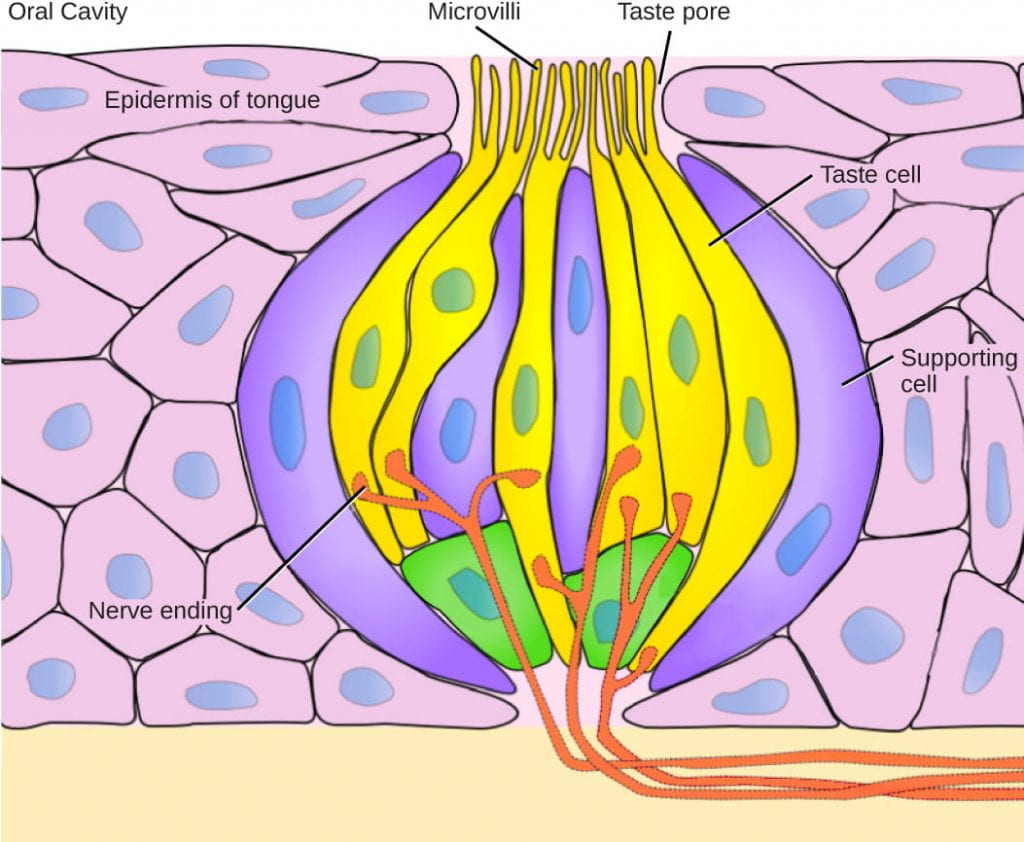
Pores in the tongue permit tastants to collaborate with and activate gustatory receptors in the gustation bud. Each receptor cell contains the receptors for only one blazon of tastant, merely each gustation bud contains all types of taste receptor cells. (credit: OpenStax Biology, modification of work past Vincenzo Rizzo)
Smell: the Olfactory System
Season includes a lot more than than just the five master tastes; most people can detect a difference between the sweet flavors of different types of fruit rather than detecting all of them as merely "sweet." But the nuance of flavor doesn't actually come from gustation at all; information technology comes from our sense of smell. This is why many people temporarily lose their sense of gustation when they take a cold or other severe nasal congestion.
All odors that we perceive are molecules in the air we breathe. If a substance does not release molecules into the air from its surface, it has no odor. And if a human or other animate being does non have a receptor that recognizes a specific molecule, then that molecule has no smell. Humans have about 350 olfactory receptor subtypes that work in various combinations to let us to sense nearly 10,000 unlike odors. (Every bit you may exist expecting past now, each olfactory receptor cell has only ane type of olfactory receptor protein, significant each receptor cell is specific to only one type of odorant.) For comparison, mice take about 1,300 olfactory receptor types and therefore probably sense many more odors than practise humans.
How does the sense of scent work?
- Odorants(aroma molecules) enter the nose and deliquesce in the olfactory epithelium, located at the back of the nasal cavity. Theolfactory epithelium is a collection of specialized olfactory receptors in the back of the nasal cavity that spans an area about five cm2 in humans. Similar to tastants, which must be dissolved in saliva, an odorant molecule must exist dissolved in fungus in order to exist detected past its receptor.
- Anolfactory receptor, which is a dendrite of a specialized sensory neuron, responds when information technology binds sure molecules inhaled from the environment by sending impulses direct to the olfactory bulb of the brain. Humans accept almost 12 million olfactory receptors, distributed amid hundreds of dissimilar receptor types that reply to unlike odors. Twelve million seems similar a large number of receptors, but compare that to other animals: rabbits accept about 100 million, near dogs have virtually 1 billion, and bloodhounds, dogs selectively bred for their sense of smell, take about iv billion. The overall size of the olfactory epithelium as well differs between species, with that of bloodhounds, for example, being many times larger than that of humans.
- Each olfactory neuron has a single dendrite buried in the olfactory epithelium, and extending from this dendrite are hair-like cilia that trap odorant molecules. The sensory receptors on the cilia are proteins, and slight variations in the protein sequences make them sensitive to different odorants.
- Each olfactory sensory neuron has only one type of receptor protein on its cilia, and the receptors are specialized to detect specific odorants, and so each olfactory neuron is capable of detecting only a single type of odorant molecule.
- When an odorant binds with a receptor that recognizes it, the sensory neuron associated with the receptor is is depolarized and relays action potentials to the brain.
- Olfactory stimulation is the merely sensory information that directly reaches the cerebral cortex, whereas other sensations are relayed through the thalamus.
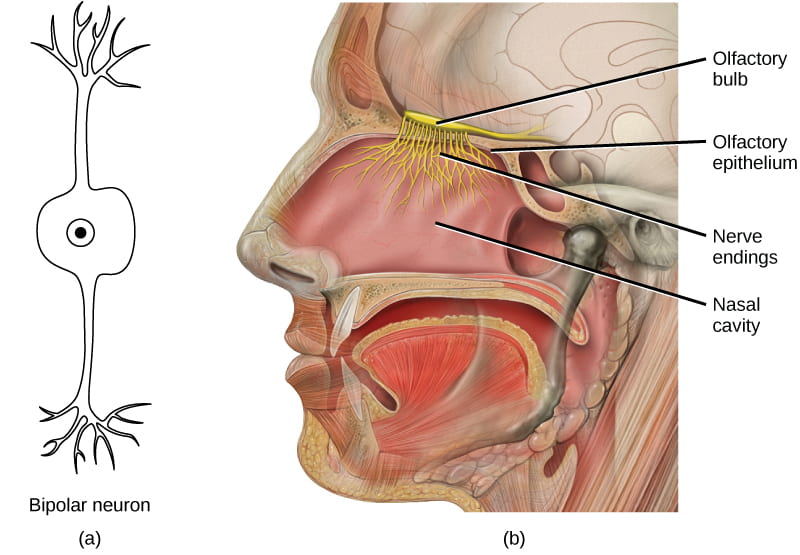
In the human olfactory system, (a) bipolar olfactory neurons extend from (b) the olfactory epithelium, where olfactory receptors are located, to the olfactory bulb. (Image credit: OpenStax Biology, modification of work by Patrick J. Lynch, medical illustrator; C. Carl Jaffe, MD, cardiologist)
Our ability to find and translate flavor is due to the combination of gustatory and olfactory senses:
- Taste receptors are responsible for the sense of how salty, sweet, bitter, sour, or savory a food is, via tastants dissolved in saliva
- Olfactory receptors are responsible for the flavor of a food, via odorants detected in the olfactory epithelium during chewing, through a procedure calledretronasal olfaction(the flow of air from the back of the throat upwardly to the olfactory epithelium via the back of the nose)
This video review how olfaction works:
Nociceptors: Tissue Impairment and Hurting
Hurting is the proper name given to nociception, which is the neural processing in response to tissue damage. Pain is caused by both true sources of injury, such as contact with a corrosive chemic, and too by harmless stimuli that mimic the action of dissentious stimuli, such as contact with capsaicins, the compounds that cause peppers to taste hot (and which are used in self-defense pepper sprays and certain topical medications). Peppers taste "hot" considering the protein receptors that bind capsaicin open the same calcium channels that are activated by rut-sensitive thermoreceptors.
In that location are many different types of nociceptors and we volition not describe them in this grade, simply the important thing to sympathise is that unlike types of nociceptors are activated past unlike types of tissue damage, including extremes of hot or cold, toxic chemicals, and farthermost mechanical deformation such as stretching, cuts, and tears.
Nociception starts at the sensory receptors, but pain does not actually offset until it is communicated to the brain; hurting is the interpretation of the tissue damage, not the actual stimulus itself. There are several nociceptive pathways to and through the brain, including through the thalamus (similar almost other sensory systems) and directly to the hypothalamus , which modulates the cardiovascular and neuroendocrine functions of the autonomic nervous system, where information technology can directly activate the fight-or-flight response.
This video discusses nociceptor function while explaining how hurting relievers work (the details of how pain relievers piece of work are not relevant to this grade, though y'all may find the word interesting):
Here are some additional videos to help you put this all together (in a more entertaining mode than many of the videos in a higher place). Note that these videos do not provide whatever new information, but they may aid y'all amend integrate all the information previously discussed:
This video provides an engaging review of hearing and balance (bonus points if you get the film reference!)
This video provides an engaging review of vertebrate eye function:
This video provides an engaging review of olfaction and gustation:
Source: https://organismalbio.biosci.gatech.edu/chemical-and-electrical-signals/sensory-systems-i/
Posted by: oglesbysorocalked.blogspot.com

0 Response to "How Do Sensory Systems Differ For Humans Versus Nonhuman Animals?ã¢â‚¬â€¹"
Post a Comment